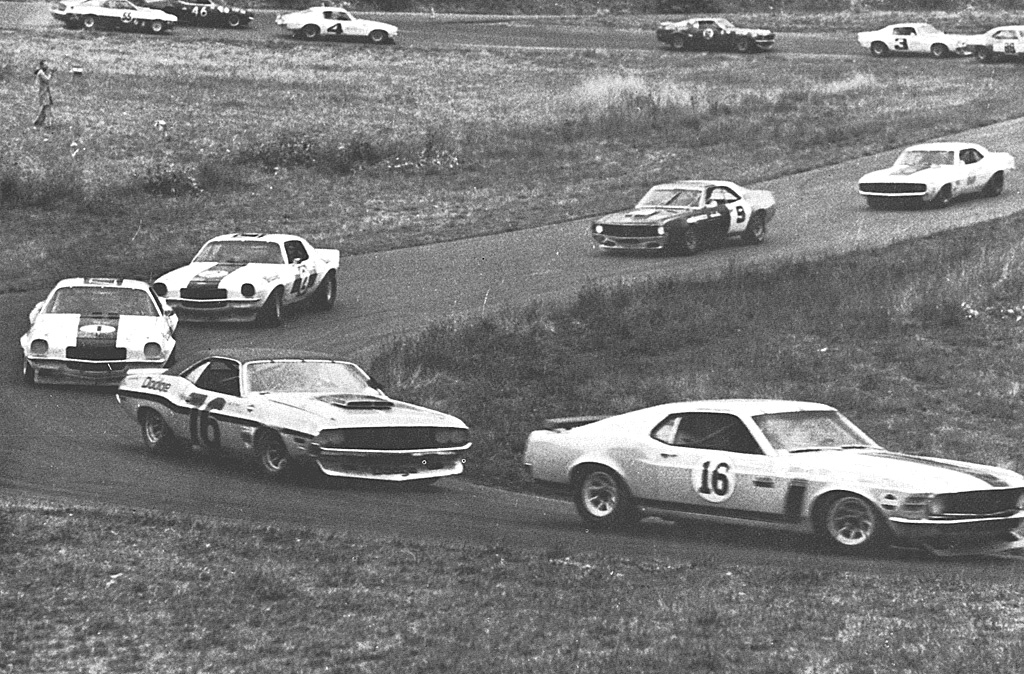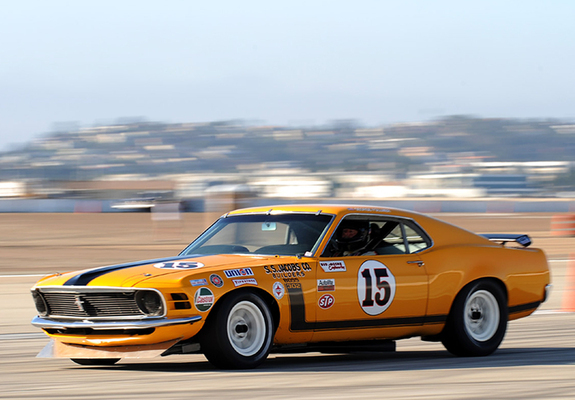Ford Finally Wins Again
| Shelby Racing Menu | 1970 TransAm Racing | 1970 Trans-Am Schedule | ’69-70 Trans-Am Gallery |
| 1969 TransAm Racing | 1969 Trans-Am Schedule | Group 2 Racing |
The 1970 Trans Am season was a replay of the prior year’s manufacturer wars with one major exception, the Shelby Racing team pulled out of Trans Am racing totally. Trans Am racing had become the top race in the country. Attendance was way up at the races. The Ford Boss 302’s and Z-28 Camaros were competing for street sales with the public.
The competition was going to be tough in 1970. Penske took his team, including Mark Donahue to American Motors leaving Chevy. Chrysler was back with two cars, a Plymouth Barracuda and a Dodge Challenger. Jerry Titus was back in a Firebird for Pontiac even though GM wasn’t officially supporting racing. Chevy hired Jim Hall for the Camaro team.
Chrysler was serious about the’70 Trans Am series. The company was losing a lot of money and saw the Trans Am races as a way to sell more cars. Phil Remington, late of Shelby American, was hired to build the race cars at the All American Racers in Costa Mesa, CA. Chief Chrysler engineer, Pete Hutchinson, was tweaking the destroked 340.
engine to 460 horse power. Dan Gurney was the lead driver. The Dodge Challenger team had an identical car to the Barracuda, except the engine was built by Keith Black and the driver was Sam Posey, who won his first Trans Am race in a Shelby Boss 302 at Lime Rock. Both cars had seen little track time prior to the series beginning.
The American Motors Javelin team looked like the team the Moore Mustangs had to beat. Chuck Cantwell, a former suspension magician at Shelby American, had joined the team the prior year. Mark Donahue was the lead driver. The engines were specially prepped by Traco.
The Chevy team was at a great disadvantage. The loss of the Penske team and a new body that wasn’t scheduled for release until mid year threatened Chevy’s repeat of the 1969 win in 1970. Jim Hall quickly put two Camaros together. One to be driven by him and the other driver was Ed Leslie. Even though GM was officially uninvolved in racing, the Hall Camaros were factory race cars.
Pontiac was also at a great disadvantage. GM wasn’t supporting racing. The destroked 400 cid engine weighed in at 75 pounds more than the Chevy 302’s. And they only had one car to race.
Ford only sponsored one team for the ’70 season and that was Bud Moore’s team. Ford cut back 75% on its racing budget. Ford didn’t think the Shelby team could give the results based on the prior year’s performance
The Moore cars were 1969 Mustangs with 351 4V engines and 4-speeds. They were updated to ’70 sheet metal. Kar Kraft rebuilt the cars to Trans-Am specifications and shipped them to Moore. The cars were painted yellow with black center stripes. Parnelli Jones drove car #15 and George Follmer piloted car #16.
The rules were changed in 1970. The minimum production of cars was raised from the 1,000 minimum in 1969 to 1/250th of the manufacturers total production in the prior year- a minimum of 2,500 cars. Rules were relaxed in other areas. More flexibility was allowed with engines, rear ends and suspension. The dual 4 barrel carbs, allowed in 1969, were restricted to a single 4 barrel. Ford developed the Autolite In-Line carb to take advantage of this rule.
Jones and Follmer drove the Trans Am Mustangs against Mark Donahue and Pete Revson in a AMC Javelins; Swede Savage driving a Plymouth Barracuda; Sam Posey piloting a Dodge Challenger and Milt Minter, Vic Elford and Jim Hall in Chevy Camaros. It was a race to the finish and to the last race. Parnelli Jones beat out Mark Donahue by one point to give Ford its third Trans-Am Manufacturers’ Championship.

